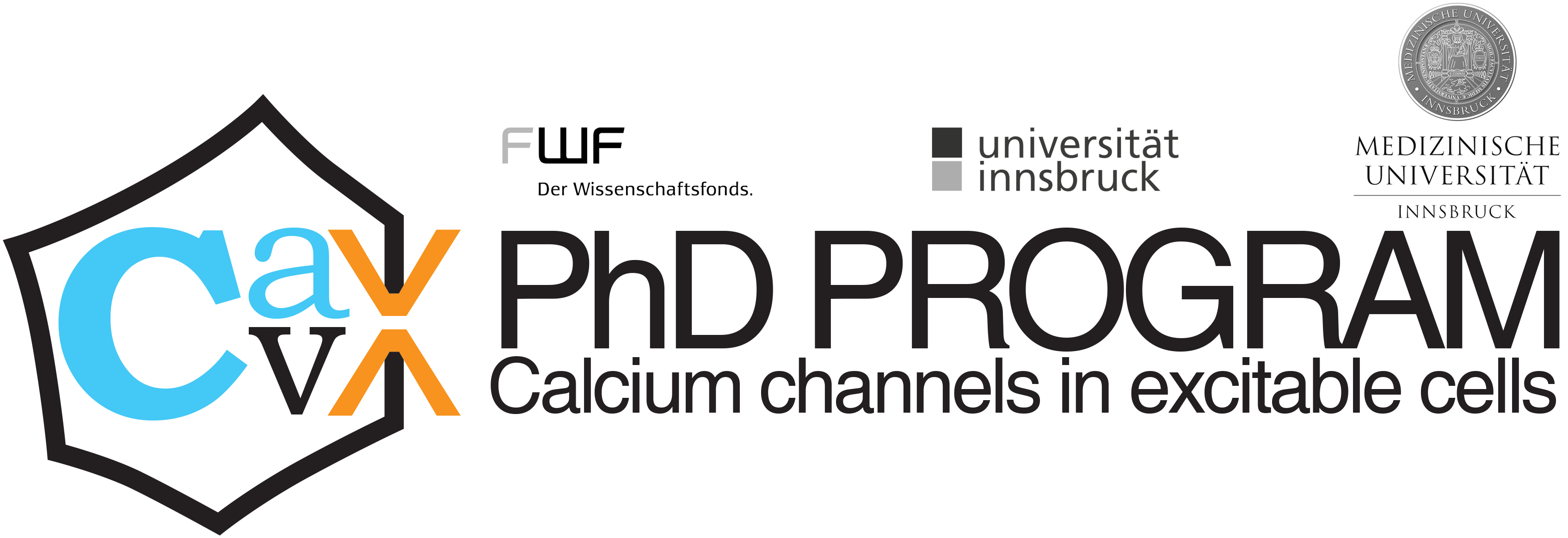// ORTNER GROUP
Keywords: Cav1.3 L-type calcium channels; CACNA1D de novo mutations; channelopathies; neurodevelopmental disorder; electrophysiology
// AIM
Mutations that alter the function of voltage-gated calcium channels (Cavs) are implicated in a variety of human diseases. This is not surprising since Cavs are expressed throughout the body, including the central nervous system, and allow tightly controlled calcium influx in response to electrical signals. There is accumulating evidence that de novo point mutations in the CACNA1D gene, encoding the pore-forming subunit of the L-type Cav1.3 subtype, cause a neurodevelopmental disorder with or without endocrine features. Our main research aims are
- to understand how these genetic Cav1.3 variants can cause the broad symptomatic spectrum observed in affected individuals
- to study which body systems and brain circuits are affected
- to test therapeutic strategies, such as pharmacological modulation of Cav1.3
// APPROACH
In our lab we have implemented several methods that allow us to study such Cav1.3 mutations on the functional, pharmacological and pathophysiological level. We use electrophysiological techniques in heterologous expression systems to study the functional impact of these mutations on channel gating as well as their drug sensitivity. We investigate the impact of Cav1.3 mutants on cellular firing and morphology (electrophysiology; calcium imaging; high-resolution microscopy) using overexpression in primary cells and neurons differentiated from patient-derived induced pluripotent stem cells (collaborations: Tuluc group; Obermair group; Edenhofer group). We have also established a construct valid mouse model harboring one of these Cav1.3 variants and have completed the basic characterization using endocrine, neuroanatomical, electrophysiological and behavioral analyses. In our current project, we will generate a novel mouse line that allows the – so far not possible – selective pharmacological targeting of Cav1.3 channels in this disease model. Using these mouse models we study cellular excitability of distinct cell types implicated in the symptomatic phenotype (electrophysiology in primary cell cultures and brain slices), identify affected brain circuits that may serve as therapeutic targets (immediate early gene IEG mapping; in vivo fiber photometry in collaboration with Prof. Jochen Roeper), determine effects on brain and/or cellular morphology (neuroanatomical analyses; high-resolution microscopy in neuronal primary cultures) and investigate pharmacological treatment options directly targeting Cav1.3 or other affected brain circuits (in vivo drug application combined with behavioral and neuroanatomical studies; in vitro experiments in primary cell cultures or brain slices).
// RESEARCH TOPICS
De novo gating-modifying missense mutations in the CACNA1D gene (encoding the pore-forming α1 subunit of Cav1.3 L-type calcium channels) have been found in individuals affected by a severe neurodevelopmental disorder with or without endocrine features. In contrast to well-studied variants causing Cav1.3 loss-of-function, which underlies congenital deafness and slight bradycardia, these missense mutations act by enhancing the activity of Cav1.3 calcium channels via changes of their gating behavior. Our group stays in contact with clinicians who treat affected patients and we use whole-cell patch-clamp recordings to characterize the identified Cav1.3 variants. The collection of such gating-modifying CACNA1D variants together with evidence from in silico molecular modeling (Fernández-Quintero group) can help to predict pathogenicity and guide diagnosis and treatment in the clinical practice. The mutation-induced gain of channel function renders inhibition of Cav1.3 a potential treatment strategy. However, no inhibitors with proven Cav1.3-selectivity exist and available non-selective L-type inhibitors (e.g. dihydropyridines, DHPs) cause Cav1.2-mediated cardiovascular side effects at doses required to efficiently target Cav1.3. We have established a mouse model harboring one of these Cav1.3 variants and observed functional and behavioral alterations compatible with the symptomatic spectrum of affected patients. By crossing this mouse line with mice carrying a point mutation that renders Cav1.2 channels insensitive to DHPs, we can circumvent this limitation and mimic Cav1.3-selectivity using DHPs. This will enable us to address the crucial question whether selective Cav1.3 inhibition can indeed attenuate the disease phenotype and thus serve as a therapeutic option for severely affected CACNA1D patients.
// LAB MEMBERS
- Group leader: Nadine Ortner
- PhD Students:
- Horia Hermenean
// ADDRESS
Pharmacology and Toxicology,
Institute of Pharmacy
University of Innsbruck
Center for Chemistry and Biomedicine
Innrain 80-82/III
A-6020 Innsbruck, Austria
// SELECTED PUBLICATIONS
Ortner NJ. CACNA1D-Related Channelopathies: From Hypertension to Autism. Handb Exp Pharmacol. 2023 Jan 3. doi: 10.1007/164_2022_626. Online ahead of print. PMID: 36592224
Török F, Tezcan K, Filippini L, Fernández-Quintero ML, Zanetti L, Liedl KR, Drexel RS, Striessnig J, Ortner NJ. Germline de novo variant F747S extends the phenotypic spectrum of CACNA1D Ca2+ channelopathies. Hum Mol Genet. 2022 Oct 8:ddac248. doi: 10.1093/hmg/ddac248. Online ahead of print. PMID: 36208199
Ortner NJ. Voltage-Gated Ca2+ Channels in Dopaminergic Substantia Nigra Neurons: Therapeutic Targets for Neuroprotection in Parkinson’s Disease? Front Synaptic Neurosci. 2021 Feb 26;13:636103. doi: 10.3389/fnsyn.2021.636103. eCollection 2021. PMID: 33716705
Ortner NJ, Kaserer T, Copeland JN, Striessnig J. De novo CACNA1D Ca2+ channelopathies: clinical phenotypes and molecular mechanism. Pflugers Arch. 2020 Jul;472(7):755-773. doi: 10.1007/s00424-020-02418-w. Epub 2020 Jun 24. PMID: 32583268
Hofer NT, Tuluc P, Ortner NJ, Nikonishyna YV, Fernándes-Quintero ML, Liedl KR, Flucher BE, Cox H, Striessnig J. Biophysical classification of a CACNA1D de novo mutation as a high-risk mutation for a severe neurodevelopmental disorder. Mol Autism. 2020 Jan 8;11(1):4. doi: 10.1186/s13229-019-0310-4. eCollection 2020. PMID: 31921405
Ortner NJ, Bock G, Dougalis A, Kharitonova M, Duda J, Hess S, Tuluc P, Pomberger T, Stefanova N, Pitterl F, Ciossek T, Oberacher H, Draheim HJ, Kloppenburg P, Liss B, Striessnig J. Lower Affinity of Isradipine for L-Type Ca2+ Channels during Substantia Nigra Dopamine Neuron-Like Activity: Implications for Neuroprotection in Parkinson’s Disease. J Neurosci. 2017 Jul 12;37(28):6761-6777. doi: 10.1523/JNEUROSCI.2946-16.2017. Epub 2017 Jun 7. PMID: 28592699
Ortner NJ, Striessnig J. L-type calcium channels as drug targets in CNS disorders. Channels (Austin). 2016;10(1):7-13. doi: 10.1080/19336950.2015.1048936. Epub 2015 Jun 3. PMID: 26039257
Ortner NJ, Bock G, Vandael DH, Mauersberger R, Draheim HJ, Gust R, Carbone E, Tuluc P, Striessnig J. Pyrimidine-2,4,6-triones are a new class of voltage-gated L-type Ca2+ channel activators. Nat Commun. 2014 Jun 19;5:3897. doi: 10.1038/ncomms4897. PMID: 24941892

